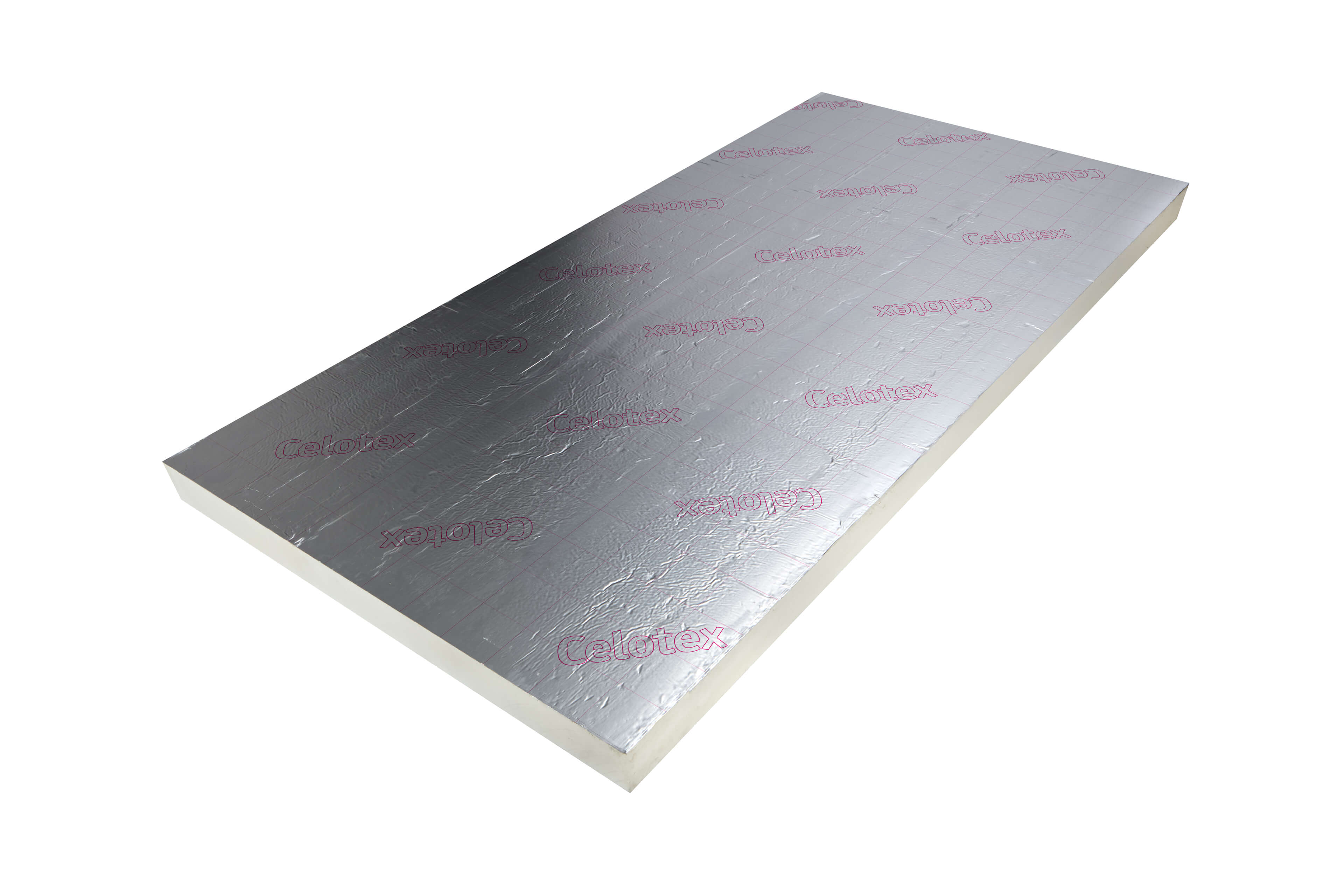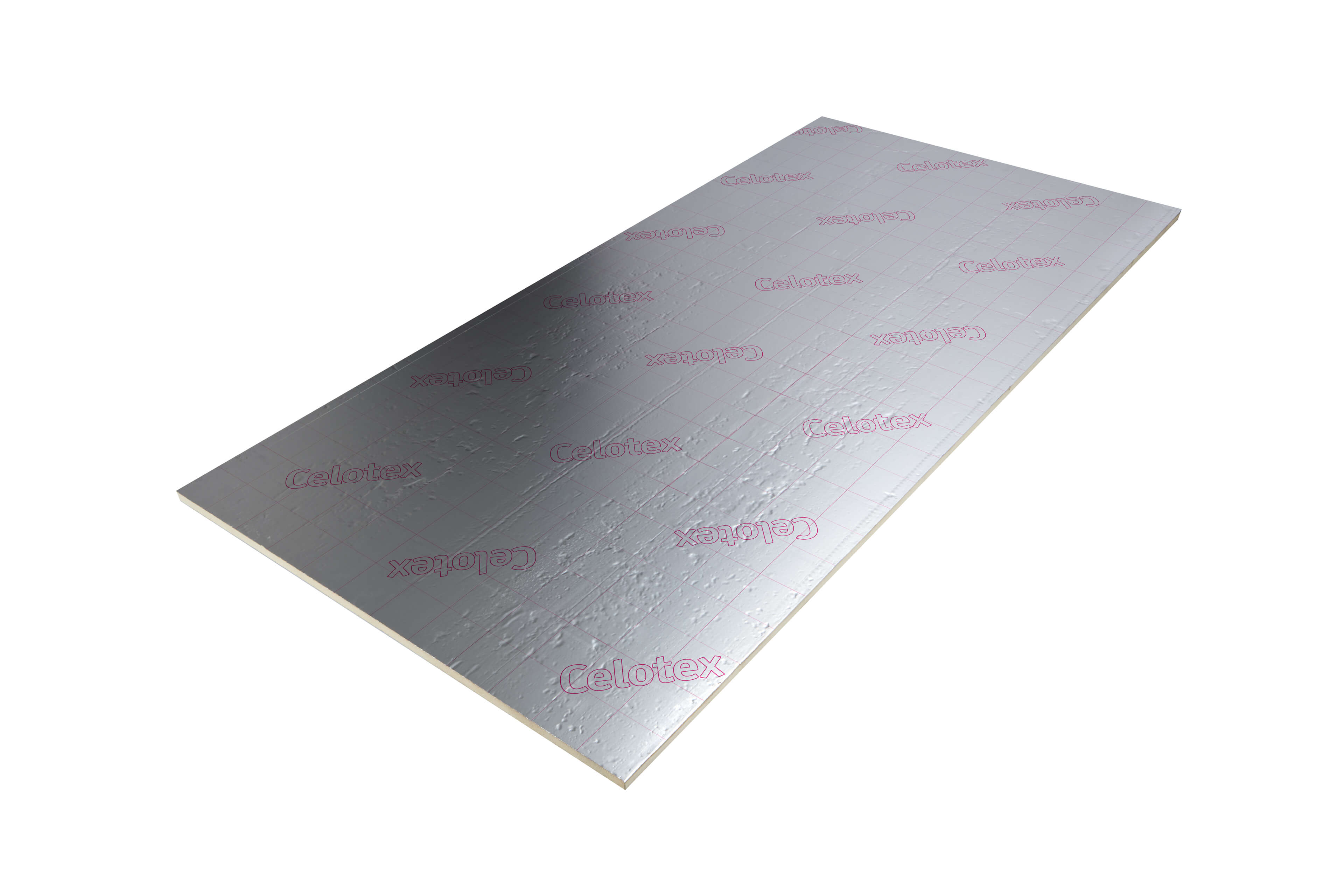Roof Insulation Board
(54 Products)Roof insulation boards are rigid panels used to improve the thermal efficiency of a building’s roof. As a key part of the thermal envelope, the roof is a major point of heat exchange between indoor and outdoor environments. These boards help limit that exchange, supporting consistent internal temperatures and greater energy efficiency.
What are Roof Insulation Boards?
Roof insulation boards are rigid panels designed to deliver strong thermal performance within flat or pitched roof systems.
Pre-formed and easy to handle, they offer a solid, stable layer that differs from loose-fill or flexible blanket insulation by holding their shape and, in many cases, supporting weight.
Most rigid roof boards are cut from dense, closed-cell foams, usually PIR (polyisocyanurate) or XPS (extruded polystyrene). Both foams slow heat flow, shrug off moisture, and stay firm under load, so the insulation keeps doing its job whether the roof is baking in summer sun or carrying winter snow.
Roof insulation boards sit over, or in some cases between, the main roof layers, forming an unbroken blanket that keeps the building’s thermal envelope intact.
How Roof-Board Insulation Blocks Heat
- Conduction: Closed-cell foams such as PIR or XPS are poor conductors: heat has a hard time travelling through the solid core of the board, so only a small amount of energy makes it from one side to the other.
- Convection: Each board is packed with minute, closed cells that hold gas in place. With nowhere to circulate, warm air can’t set up convective currents inside the insulation.
- Radiation: Many boards carry a foil skin. The shiny surface reflects radiant heat back toward its source, keeping warmth indoors in winter and bouncing summer sun away, so long as there’s a small air gap alongside the foil.
Applications
Flat roofs
- Warm Roof (Above The Deck): Boards sit on the deck and under the waterproof layer; PIR is common here.
- Inverted Roof: Boards go on top of the membrane and shield it from weather; moisture-proof XPS is the usual choice.
Pitched Roofs
- Between Rafters: Pieces are cut to fit snugly in the rafter spaces.
- Over Rafters: Large sheets run across the top, forming an unbroken blanket.
- Hybrid Build-Ups: A mix of between-and over-rafter layers hits very low U-values.
- Below Rafters: Plasterboard bonded to PIR or XPS gives insulation plus a ready-to-decorate ceiling.
Why Use Rigid Roof Boards?
- Cuts Utility Costs: A solid layer of insulation slows heat escaping in winter and blocks summer heat gain, so the boiler and air-con cycle less often.
- Levels Out Comfort: By evening out surface temperatures, the boards help remove draughts and cold patches, giving rooms a steadier, more pleasant feel.
- Meets Regulations: Makes it simpler to achieve tough U-value targets and improve the building’s EPC rating.
- Controls Moisture: When combined with a suitable vapour layer, it keeps condensation at bay and shields timber and finishes from damp or mould.
- Adds Value: An efficient roof appeals to buyers and can lift resale price.
- Built-In Strength: Once fitted, boards keep their shape; they won’t slump or settle over time.
- Saves Headroom: High-performing foams reach the target U-value with slimmer build-ups, leaving more usable space below.
Types of Roof Insulation Boards We Offer
Polyisocyanurate (PIR) Boards
PIR delivers a lot of insulation without eating up head-room. The slab is hard enough to carry loads, and if flames reach it, the surface tends to char rather than flare.
Most versions arrive with a foil skin on one or both faces, it bounces heat and can double as a vapour check.
Some manufacturers switch the foil for glass tissue when the board needs to bond firmly to hot-applied or liquid roof membranes.
Extruded Polystyrene (XPS) Boards
XPS is the go-to where water is an issue. Its closed-cell foam won’t drink in moisture, so it keeps its shape and performance even on roofs that hold standing water.
The boards are tough, too, which is why they’re often laid above the waterproof layer in inverted flat-roof build-ups: they protect the membrane while still cutting heat loss.
XPS doesn’t insulate quite as well as PIR per millimetre, but it easily meets the figures required for most flat-roof designs.
Specialised Facings
The sheet that covers a foam board does more than protect the core, it decides how the panel handles on site and which roof systems it will work with.
- Glass-Tissue Skins: A thin layer of coated glass fibre on both faces gives the board a firm, dimensionally stable surface. Roofers like it because a single-ply membrane or a built-up felt can be bonded straight onto the panel without extra primers or layers.
- Foil Laminates: When a board carries aluminium foil, the shiny face throws radiant heat back across an adjoining air space. At the same time, the foil acts as a built-in vapour check, helping to keep condensation out of the roof build-up.
- Torch-On Ready Finishes: Some manufacturers add a bitumen-soaked glass tissue that can take the heat of a torch-applied membrane. The facing softens just enough for the hot bitumen to bite, giving a reliable bond and a tidy, weather-tight seal.
Frequently Asked Roof Insulation Board Questions
Are Roof Insulation Boards Waterproof?
PIR foam will shrug off the odd splash or brief shower, but it isn’t waterproof. Prolonged exposure to rain, or any detailing where water can sit on the board, should be avoided. Keep the sheets dry on site and install them in a way that keeps moisture out of the build-up.
Which Roof Board Suits My Roof?
Start with the basics:
- Roof shape: Flat or pitched.
- Waterproof Layer: Torch-on bitumen, single-ply, tiles, metal, etc.
- Target U-Value: What the drawings (or Building Control) demand.
- Traffic Load: Will the roof carry plant or regular footfall?
- Moisture And Fire Performance: Any special requirements?
For many flat roofs:
- Warm Roof (Insulation Under The Waterproofing): PIR is a common, cost-effective choice.
- Inverted Roof (Insulation Above The Membrane): XPS copes better with constant wetting.
On pitched roofs, PIR works well both between and over rafters. When in doubt, run the options past your architect or building-control officer.
Do I Need A Vapour-Control Layer (VCL)?
Nearly always, yes. Warm, moist indoor air can drift into a roof build-up, cool, and condense, reducing insulation performance and risking timber decay. A VCL on the warm side of the board blocks that moisture path.
Foil-faced PIR often doubles as the VCL; tape the joints and seal around penetrations.
If the board has no built-in barrier, fit a separate VCL membrane and lap, tape, or seal every seam.
Can Any Board Take A Torch-On Membrane?
No. The flame used in torch-on work can scorch or melt standard PIR and XPS sheets. Use boards that carry a torch-on-compatible facing, typically a bitumen-coated glass tissue or mineral surface, and always check the manufacturer’s data sheet before ordering.







.jpg)









